Installation height of sockets and switches: where and how to position?
The location of the power points, the height of the sockets and switches is a serious issue that requires planning, drawing up schemes, calculating their number for each room.
If you approach the installation with preliminary planning, then you do not have to unwind the extension cable, stumble over the carry and plug everything in there, thereby overloading the outlet or even the network.
Our material will help you determine the optimal amount of electrical fittings and the rules for its location. We will also talk about all the intricacies of the placement and installation of electric points in an apartment or house.
The content of the article:
- Planning and installation of switches and sockets
- Features of mounting switches and sockets
- #1. Features of placement in the corridor
- # 2 Location of electric points in the bathroom
- # 3 The specifics of the installation in the living room
- #4. Kitchen layout rules
- #5. Nuances of bedroom accommodation
- # 6 Competent planning of power points in the nursery
- # 7 Subtleties of installation in the office
- Location of lighting points
- Placement Tips
- Conclusions and useful video on the topic
Planning and installation of switches and sockets
It is estimated that each person uses approximately six different electrical appliances per day. And the number is constantly growing. New devices and gadgets appear, without which it is difficult to imagine life.
Devices fill our homes, and the number of sockets remains unchanged. Cases when a person in a panic runs around the house or office, in search of a free connector for charging a smartphone, more and more occur. What is the result? You have to turn off the printer or something else.
Avoiding such situations is easy, you only need to know how to correctly position the connectors. Then it will become most comfortable to use them.
The following selection will familiarize you with the recommendations and nuances of the location of electrical fittings:
To avoid cosmetic repairs when installing / moving circuit breakers and sockets, you must always take the time to plan. For example, when ordering a project from an interior designer, the application must indicate the exact number of network connectors and circuit breakers, as well as their location.
Since the interior designer may not know that you prefer to work on a laptop on the couch. Project approval - This is the point to which all wishes are accepted and changes are made to the project.
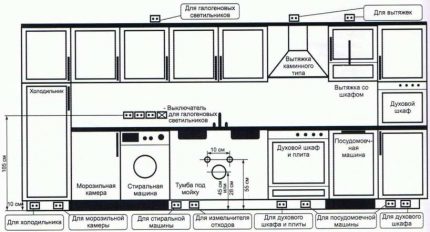
With independent planning of the interior, it is important to understand the purpose of the room and its design. The location of the furniture is also taken into account, since the outlet behind the wardrobe is a useless thing. And if you like to rearrange all the furniture in the room every six months?
It turns out that the calculation of the number of circuit breakers and sockets is carried out only after the development of the design.
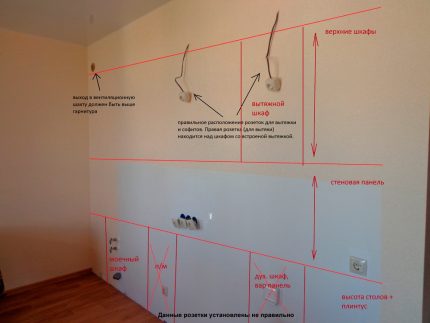
Laws and technical regulations
Construction standards that strictly regulate the number and location of network connectors and switches in the house are not prescribed at the legislative level. But there is a document called the Code of Design and Construction Rules, or SP 31-110-2003, which spells out recommendations on where to place circuit breakers and power connectors.
The first are located on the side of the door handle at a height of up to 1000 mm, and the second - in a convenient place, but at the same height. It should be guided only by common sense and own choice.
Rules for placing switches
The switch for the main lighting is usually placed near the doorway at a height of 750–900 mm. Height calculation should be based on the average height of all adults in the family. As a result, everyone should comfortably press the switch button without raising their hands.
The level of 800 mm will be comparative for all exemplary. The switch must be positioned so that when the door is closed, it is on the side of the handle, and not vice versa. Then, when opened, the door will not block it. Also, you can not block access to the switch with various furniture and cabinets.

Power points for lighting fixtures in the bathroom, restroom and pantry must be mounted in the hallway. For living rooms, the kitchen, as well as the corridor itself, the location inside the premises will be correct.
Wiring devices for adjusting auxiliary or decorating lighting are mounted in a convenient place, but taking into account the design.
Advantages and disadvantages of the Soviet and Euro standards
The outdated “Soviet” method of locating electric points has such strengths:
- more people in the CIS countries consider this option more convenient, respectively, when there is demand, you can find an excellent offer;
- the switch is almost at eye level;
- You can install furniture under it, and it will not block the switch;
- the safest option for children;
- the location of the outlet will allow you to comfortably connect the appliance, without preliminary "bows."
But if the device connected to such an outlet always stands in one place, this method looks less attractive. Since the wires, and the outlet itself will be in a prominent place.
At the same time, Eurostandard is:
- high ergonomics, pleasant and easy to use;
- regulation of lighting devices "blind", as well as with a lowered hand;
- maximum "secrecy" from public viewing.
But this option involves additional protection from children, and also to bend devices you must always bend down. Installation of additional furniture in any case will block the device mounted in the wall.
The pros and cons of European standards in the field of location of switches and sockets are indicated in the gallery:
Features of mounting switches and sockets
The reason for long discussions is the height of the outlets from the floor. Since there is no exact definition anywhere, you can use concepts such as “European standard” or “Soviet standard”. When an “European-quality repair” is planned in the apartment, most likely the sockets will be placed at a level of 300 mm from the floor, but the switches will be already 900 mm.
According to the "Soviet standard", the switch would be installed at shoulder level - this is about 1600 mm, and the outlet is also much higher - at the level of 900 mm from the floor.
Each method has its pros and cons. We will consider them briefly.

#1. Features of placement in the corridor
For the hallway, 1-2 outlets are enough. It is better to place them in a corner near the baseboard at about 15-20 cm from the floor. This will allow you to connect various household appliances, for example, a vacuum cleaner, an electric dryer for shoes or charging for a phone.
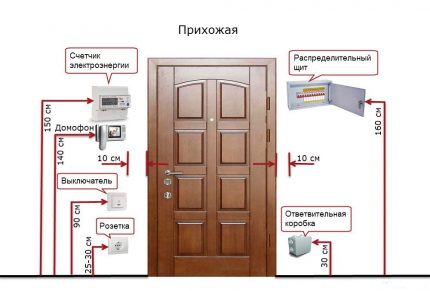
In addition, other devices will fit perfectly into the corridor.
Among them:
- apartment distribution board with circuit breakers;
- Voltage regulator;
- electric meter, although a separate place on the stairwell is provided for apartments, it can also be mounted in the corridor;
- switches for the kitchen, bath and restroom;
- junction box for TV cable, Ethernet or landline telephone;
In most cases, this is enough, but sometimes they also provide for installing a floor heating sensor in the corridor.
# 2 Location of electric points in the bathroom
Of course, the amount number of electrical outlets in the bathroom will depend on the area and number of devices, but in 95% of cases, 1-2 outlets will be enough. The first is preferably located near the mirror at a level of 1000 mm from the floor. A hairdryer and electric shaver will be connected to it. To the second, for example, connected washing machine or heater. In this case, at least 600 mm from the floor for the machine, and 1500 mm for the boiler.
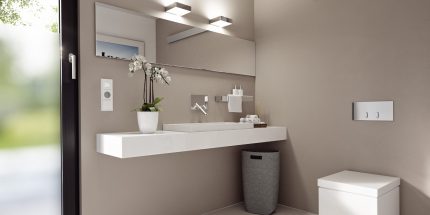
It goes without saying that it is strictly contraindicated to fasten both sockets next to the water tapping device, therefore there should be more than 600 mm, and preferably 1000 mm, of the indents from the bathtub and sink. Without fail, you should worry about moisture protection, install a waterproof outlet.
We must not forget that products may be at even greater risk. Since the bathroom is at risk of flooding, it is completely unsafe to mount products below 150 mm from the floor. If water gets into the outlet, the threat to life is simply enormous.
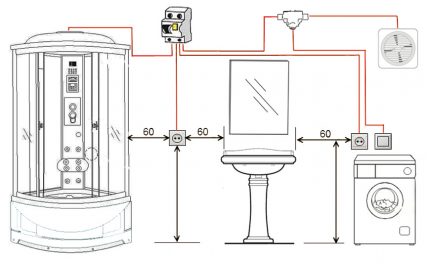
The reasons for this can be various situations, from leakage of a tap or pipe, to the breakdown of household appliances or the forgetfulness of the owners.
# 3 The specifics of the installation in the living room
Home theater or simple TV box will require a separate outlet, and better than two. The first for the TV receiver itself, and the second for the satellite receiver. The height level should be determined based on the location of the TV itself. It can stand on a pedestal, be mounted in a wall or fit in a special cell of a furniture wall.
The power cable cannot hang or be pulled. It should be completely hidden behind the screen.
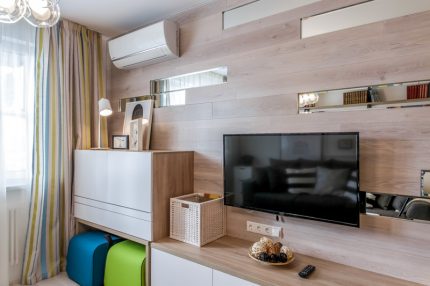
On each wall, additional 2 sockets should be placed at a level of 150-300 mm from the floor. It will be possible to connect a floor lamp, a fan, gadget chargers, a game console, and a vacuum cleaner in them.
You should worry about the possibility of conveniently connecting the air conditioner.
If there will be a personal computer in the living room, you will need to take care of a separate power point and for it. And how to connect it, read here.

#4. Kitchen layout rules
Every year, he develops an increasingly clever technique to ensure the comfort and time of a person. Naturally, the amount of equipment, and therefore kitchen outlets sometimes just rolls over. It is imperative to provide for the connection of a hood, possibly a washing machine, dishwasher, and electric stove.
But the main thing is a refrigerator, a microwave or a crock-pot, sometimes both.The mixer, juicer, combine, toaster, blender, coffee maker and TV - this list is probably endless.
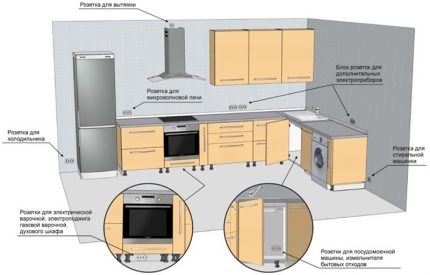
Behind the refrigerator, an outlet is usually installed at a level of 600-800 mm. For hoods, it is advisable to increase the height three times - 1800–2000 mm from the floor.
At plug in a power outlet must be mounted 200-300 mm from the floor. Additionally, for him, a hole is cut out on the rear wall of the kitchen furniture, if any.

Having estimated the place of the future work surface, it is necessary to provide connectors there. It is advisable to place at least three outlets 100-200 mm higher than the countertop for connecting small equipment.
The TV in the kitchen is most often mounted on wall brackets, respectively, the height of the outlet for this household appliance can be from 1800 to 2000 mm from the floor.
#5. Nuances of bedroom accommodation
In this room, four items are sufficient, two outlets on each side of the bed. They will be intended for a bedside lamp, an electronic clock or additional devices, for example, an air conditioner, fan or vacuum cleaner. Near the chest of drawers with a mirror, it is also advisable to install one outlet at a level of 600-700 mm from the floor to connect a hair dryer or hair iron.
If there will be a TV or PC in the room, you should also consider where to hide the wires and how to place the connectors on the mains.
# 6 Competent planning of power points in the nursery
A children's room is usually a combination of a bedroom and a play area. This room also can not do without power connectors. It is desirable that they be at least 2-3. You can place a lamp near the crib, and the rest for additional purposes.
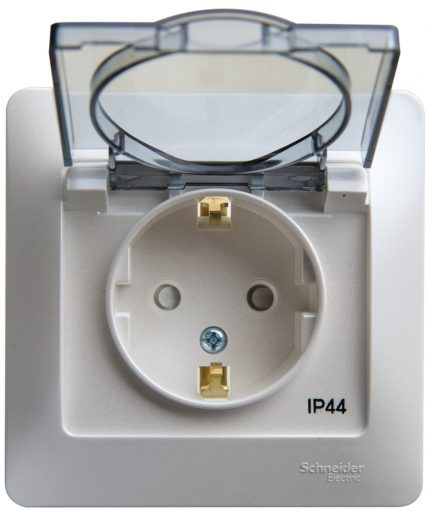
Many experts warn that the plugs must be mounted as high as possible from young children. In this they were right several years ago.
Modern developments have made it possible to equip products with additional protective covers that prevent the child from contacting the power grid. Such valves often require considerable effort to gain access to the plug holes. Spontaneous childish curiosity will be stopped.
# 7 Subtleties of installation in the office
This room is not much different from the living room in the location of the connectors. A minimum of 5–6 devices will be required to connect a PC — a system unit, a screen, audio speakers, a scanner, and a table lamp. Near the shelves for books you need to provide a place for reading.
The installation of a lamp and a comfortable chair should be included in the project plan, and this is another auxiliary connector. Two other devices are placed on an unoccupied wall. Each connector is mounted at a height of 150-300 mm from the floor.
There are two options for connecting an air conditioner. Directly through an automatic machine or through an outlet. In the first version there will be no hanging cords, but it is necessary to choose a high-quality machine, on which the functioning of the device will depend. In the second case, the outlet must be placed at a level of 300 mm from the ceiling.
Location of lighting points
Lighting control points in the house are divided into three main groups:
- Classical switches got here - these are devices of different types, often with one or two keys. But thanks three-key switches, you can simultaneously use three different groups of lighting installations.
- This group includes switches, by using which, regulation is carried out by several light sources at once from different places.
- This group includes devices in which the mechanisms that control the lighting are already built into the lighting tools. Among them are a table lamp and a floor lamp /
In the apartment, almost all rooms are equipped with one or two-gang switchesthat is considered justified, and most importantly comfortable.

For example, for a bathroom, an additional light source can be a lamp above a mirror. But regulation for such a device is carried out using the built-in switch
The bedroom has its own unique switch system. It allows you to adjust the light source simultaneously from different places. Consider the convenience of an example.

Every time you need to turn the light on or off, you have to get out of bed, because the knife switches are quite far from the bed. The solution is obvious. Three switches are mounted at once in the room. One is at the exit of the room, and the other two are on either side of the bed. As a result, it became very simple to regulate the lighting in the bedroom, and access to the knife switches will be at hand.
Placement Tips
Where and how to place switches and sockets must be determined only on the basis of safety and, of course, comfort. To date, there are no prescribed standards that specify a place for placement of power connectors and switches. Especially their number in a separate room.
Planning is the stage of calculating the number of mechanisms that a person will use on an ongoing basis, regardless of the premises. Plus another 1-2 sockets on top for additional devices. The most stringent requirements are imposed only on the masters who install electrical appliances in the apartment. Such people should be specialists with good experience.
But if it was decided to carry out all the work yourself, then you need to get acquainted with all types of electrical equipment. Because the product range very wide, which means that for every need you can find equipment.
It can be an audio socket, allowing you to connect speakers, a stereo system or a connector for a landline phone, as well as socket for Ethernet cable.
The installation height determines the comfortable living conditions in the house, its safety, improvement and beauty.
Conclusions and useful video on the topic
The intricacies of installing sockets and switches in the kitchen are demonstrated in the video:
Where to harmoniously arrange switches and sockets:
Suitable height for mounting sockets and switches:
Before you begin, remember that electricity is not a toy. It requires an ideal approach to business. It is advisable to entrust the installation of sockets and equipment in the kitchen, in the bathroom and in the corridor to a professional electrician who has specialized approvals for electrical work.
Have questions about the topic of the article, or do you have recommendations for counting and installing electric points in the room? Please leave your suggestions in the comments below the article.

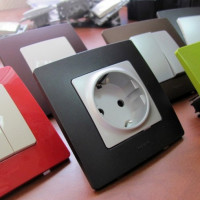 Types of electrical outlets and switches: what are and how to choose wisely
Types of electrical outlets and switches: what are and how to choose wisely 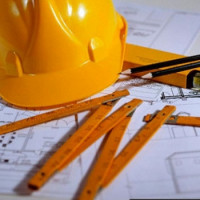 Designation of sockets and switches in the drawings and diagrams
Designation of sockets and switches in the drawings and diagrams  How to connect an outlet block: installation rules and connection diagrams
How to connect an outlet block: installation rules and connection diagrams  Placement and installation of sockets in the kitchen: the best schemes + installation instructions
Placement and installation of sockets in the kitchen: the best schemes + installation instructions  Installation of sockets in the bathroom: safety standards + installation instruction
Installation of sockets in the bathroom: safety standards + installation instruction 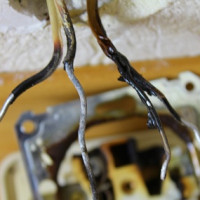 Common Outlet Malfunctions: How to Fix an Outlet Do It Yourself
Common Outlet Malfunctions: How to Fix an Outlet Do It Yourself  How much does it cost to connect gas to a private house: the price of organizing gas supply
How much does it cost to connect gas to a private house: the price of organizing gas supply  The best washing machines with dryer: model rating and customer tips
The best washing machines with dryer: model rating and customer tips  What is the color temperature of light and the nuances of choosing the temperature of the lamps to suit your needs
What is the color temperature of light and the nuances of choosing the temperature of the lamps to suit your needs  Replacement of a geyser in an apartment: replacement paperwork + basic norms and requirements
Replacement of a geyser in an apartment: replacement paperwork + basic norms and requirements
The main thing, besides taking into account the height, is to remember during the planning stage that there are not many sockets!) And it is better to put the extra ones than they will not be sorely needed. And you need to have a 100% plan for arranging furniture in the kitchen. And to know how tall the sofa will be if you want to put a socket above it. We made some changes at the very last moment, and as a result, the microwave was on the opposite side from the outlet intended for it, and at a completely different height, we had to ditch the walls again. And do not forget about food for the dishwasher, even if it is not planned. Then as you find.
I personally adhere to the “Soviet” standard for the location of sockets and switches. When we moved to a new apartment, for a long time I could not get used to the switches at the level of the lowered hand and to the sockets located even lower. For me, the main disadvantage of this arrangement is the danger to the children, well, their own psychological habit. And yet, the sockets are always pushed back, either by the nightstand or by the chest of drawers, they are forced by something.
I don’t see a single plus of the “European standard”; most likely, I will rearrange it at the next repair.
Vadim, what is the danger for children when placed according to the European standard?
So that children do not have contact with live parts, take sockets of normal manufacturers, with protective curtains and put appropriate protection in the apartment panel. But to go after the child to turn on the light for him, with a switch height of 160-170 cm, you will have to until the child turns 7 years old. That’s another convenience, didn’t you think about it?
I agree that for a child you have to turn on the light several times in the evening - do not strain. But if this child, or even two and three, begins to click the light switch all day because they can easily reach it and they won’t prove what is impossible, because they are interested and they are under 7 when they start something understand - this is annoying!
Do you feel sorry for the switch or the child’s interest in the switch ??? Play enough and throw, what's wrong?
When there is no hot water, and you carry a pot of boiling water into the bathroom, and the switch is installed according to the Soviet standard, you have to turn on the light in the bathroom with your nose, according to European standards - with the back of your hand, without raising the pot of boiling water.
I wonder what the author means by the word “Circuit Breaker”? After all, a knife switch in a simple way is a manually-activated knife-shaped contact that enters between two spring contacts (“tweezers”), hence the expression “cut” and “cut”. Have you seen this in your apartment ??? And the author should know the Electrical Installation Rules (PUE) - it says at what height switches and sockets should be. Here is an excerpt from these Rules:
6.6.30. Sockets must be installed:
- in production facilities, as a rule, at a height of 0.8–1 m; when supplying wires from above, installation at a height of up to 1.5 m is allowed;
- in administrative-office, laboratory, RESIDENTIAL and other rooms at a height convenient for connecting electrical appliances to them, depending on the purpose of the premises and interior decoration, but not higher than 1 m. It is allowed to install sockets in (on) specially adapted for this skirting boards made of non-combustible materials;
- in schools and child care facilities (in rooms for children) - at a height of 1.8 m.
6.6.31. Switches for general lighting fixtures should be installed at a height of 0.8 to 1.7 m from the floor, and in schools, nurseries and kindergartens, in rooms for children, at a height of 1.8 m from the floor. It is allowed to install switches under the ceiling with control by means of a cord.